Sterol Biosynthesis Pathway as Target for Anti-trypanosomatid Drugs
- PMID: 19680554
- PMCID: PMC2721973
- DOI: 10.1155/2009/642502
Sterol Biosynthesis Pathway as Target for Anti-trypanosomatid Drugs
Abstract
Sterols are constituents of the cellular membranes that are essential for their normal structure and function. In mammalian cells, cholesterol is the main sterol found in the various membranes. However, other sterols predominate in eukaryotic microorganisms such as fungi and protozoa. It is now well established that an important metabolic pathway in fungi and in members of the Trypanosomatidae family is one that produces a special class of sterols, including ergosterol, and other 24-methyl sterols, which are required for parasitic growth and viability, but are absent from mammalian host cells. Currently, there are several drugs that interfere with sterol biosynthesis (SB) that are in use to treat diseases such as high cholesterol in humans and fungal infections. In this review, we analyze the effects of drugs such as (a) statins, which act on the mevalonate pathway by inhibiting HMG-CoA reductase, (b) bisphosphonates, which interfere with the isoprenoid pathway in the step catalyzed by farnesyl diphosphate synthase, (c) zaragozic acids and quinuclidines, inhibitors of squalene synthase (SQS), which catalyzes the first committed step in sterol biosynthesis, (d) allylamines, inhibitors of squalene epoxidase, (e) azoles, which inhibit C14alpha-demethylase, and (f) azasterols, which inhibit Delta(24(25))-sterol methyltransferase (SMT). Inhibition of this last step appears to have high selectivity for fungi and trypanosomatids, since this enzyme is not found in mammalian cells. We review here the IC50 values of these various inhibitors, their effects on the growth of trypanosomatids (both in axenic cultures and in cell cultures), and their effects on protozoan structural organization (as evaluted by light and electron microscopy) and lipid composition. The results show that the mitochondrial membrane as well as the membrane lining the protozoan cell body and flagellum are the main targets. Probably as a consequence of these primary effects, other important changes take place in the organization of the kinetoplast DNA network and on the protozoan cell cycle. In addition, apoptosis-like and autophagic processes induced by several of the inhibitors tested led to parasite death.
Figures
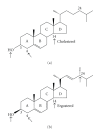
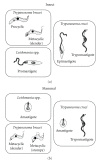
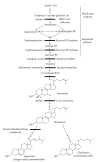


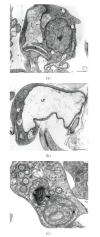
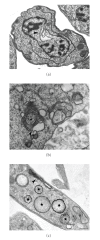







Similar articles
-
Squalene synthase as a chemotherapeutic target in Trypanosoma cruzi and Leishmania mexicana.Mol Biochem Parasitol. 2002 Nov-Dec;125(1-2):35-45. doi: 10.1016/s0166-6851(02)00206-2. Mol Biochem Parasitol. 2002. PMID: 12467972
-
Fatty acid and sterol metabolism: potential antimicrobial targets in apicomplexan and trypanosomatid parasitic protozoa.Mol Biochem Parasitol. 2003 Feb;126(2):129-42. doi: 10.1016/s0166-6851(02)00280-3. Mol Biochem Parasitol. 2003. PMID: 12615312 Review.
-
Inhibition of squalene synthase and squalene epoxidase in tobacco cells triggers an up-regulation of 3-hydroxy-3-methylglutaryl coenzyme a reductase.Plant Physiol. 2002 Sep;130(1):334-46. doi: 10.1104/pp.004655. Plant Physiol. 2002. PMID: 12226513 Free PMC article.
-
Sterol Biosynthesis Pathway as an Alternative for the Anti-Protozoan Parasite Chemotherapy.Curr Med Chem. 2015;22(18):2186-98. doi: 10.2174/0929867322666150319120337. Curr Med Chem. 2015. PMID: 25787966 Review.
-
Inhibitors of sterol biosynthesis and amphotericin B reduce the viability of pneumocystis carinii f. sp. carinii.Antimicrob Agents Chemother. 2000 Jun;44(6):1630-8. doi: 10.1128/AAC.44.6.1630-1638.2000. Antimicrob Agents Chemother. 2000. PMID: 10817720 Free PMC article.
Cited by
-
Hesperidin Targets Leishmania donovani Sterol C-24 Reductase to Fight against Leishmaniasis.ACS Omega. 2021 Mar 16;6(12):8112-8118. doi: 10.1021/acsomega.0c05858. eCollection 2021 Mar 30. ACS Omega. 2021. PMID: 33817470 Free PMC article.
-
Trypanosoma cruzi response to sterol biosynthesis inhibitors: morphophysiological alterations leading to cell death.PLoS One. 2013;8(1):e55497. doi: 10.1371/journal.pone.0055497. Epub 2013 Jan 31. PLoS One. 2013. PMID: 23383204 Free PMC article.
-
Ketanserin, an antidepressant, exerts its antileishmanial action via inhibition of 3-hydroxy-3-methylglutaryl coenzyme A reductase (HMGR) enzyme of Leishmania donovani.Parasitol Res. 2014 Jun;113(6):2161-8. doi: 10.1007/s00436-014-3868-y. Epub 2014 Apr 12. Parasitol Res. 2014. PMID: 24728519
-
Antiproliferative, Ultrastructural, and Physiological Effects of Amiodarone on Promastigote and Amastigote Forms of Leishmania amazonensis.Mol Biol Int. 2011;2011:876021. doi: 10.4061/2011/876021. Epub 2011 Jun 13. Mol Biol Int. 2011. PMID: 22091415 Free PMC article.
-
Sterol methyltransferase a target for anti-amoeba therapy: towards transition state analog and suicide substrate drug design.J Lipid Res. 2017 Dec;58(12):2310-2323. doi: 10.1194/jlr.M079418. Epub 2017 Oct 17. J Lipid Res. 2017. PMID: 29042405 Free PMC article.
References
-
- Fagundes LJM. Estudo de esteróis e lipídeos totais em Leptomonas pessoai cultivada a 28°C e 37°C. Rio de Janeiro, Brazil: Instituto de Microbiologia da Universidade Federal do Rio de Janeiro; 1974. M.S. thesis.
-
- de Souza W, Sant'anna C, Cunha-e-Silva NL. Electron microscopy and cytochemistry analysis of the endocytic pathway of pathogenic protozoa. Progress in Histochemistry and Cytochemistry. 2009;44(2):67–124. - PubMed
-
- Soares MJ, de Souza W. Endocytosis of gold-labeled proteins and LDL by Trypanosoma cruzi . Parasitology Research. 1991;77(6):461–468. - PubMed
-
- Urbina JA. Lipid biosynthesis pathways as chemotherapeutic targets in kinetoplastid parasites. Parasitology. 1997;114(supplement 1):S91–S99. - PubMed
-
- Roberts CW, McLeod R, Rice DW, Ginger M, Chance ML, Goad LJ. Fatty acid and sterol metabolism: potential antimicrobial targets in apicomplexan and trypanosomatid parasitic protozoa. Molecular and Biochemical Parasitology. 2003;126(2):129–142. - PubMed
LinkOut - more resources
Full Text Sources
Other Literature Sources

